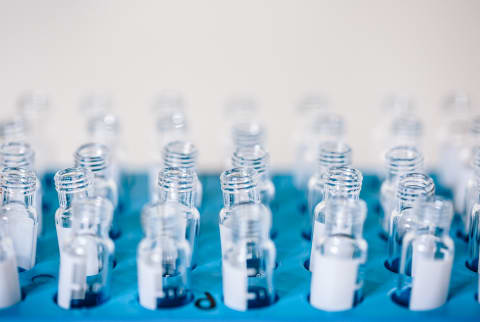Advertisement
4 Lab Tests To Try If You're Over 40, Have Low Energy & No Sex Drive


During our initial consultation, my 39-year-old patient Virginia mentioned she got sick often, frequently felt anxious or stressed out, and couldn't lose weight. Plus, she confessed that things had shut down in the bedroom years ago. Unfortunately, these types of complaints are all too common in my patients of a certain age.
We switched up Virginia's diet and incorporated weight resistance exercises several times a week. We discussed stress management strategies. In other words, we ticked all those health and wellness boxes, which eventually helped improve her condition immensely.
But what creates these issues in the first place? Understanding why things like this happen—things like low sex drive and weight loss resistance—can provide better long-term strategies to keep them at bay.
Why you should get lab tests done.
When you test rather than guess, you know exactly what your lab numbers are. And if those numbers are out of balance, you can work with your health care practitioner to get them within the ideal range.
Here are the types of issues I am trying to uncover when I order lab tests for a patient:
- What chronic problems your body struggles with (inflammation)
- Whether you're insulin resistant or at increased risk for diabetes (blood sugar)
- Are you aging prematurely (immune system)
- Why you have poor energy, memory, and sex drive (hormones)
- How you can better handle stress
You can order these four tests easily and inexpensively, either through your health care practitioner or on your own. Let's look at why tests can help you and the ideal lab numbers you'll want to look for on each.
Vitamin D
About 40% of Americans1 could be deficient in vitamin D. But those are just deficiencies. If we consider optimal levels, that range might be as high as 80% or more—yikes!
That's unfortunate considering vitamin D contributes to your immune system, mood, memory, and so much more. Deficiencies can be a factor in a vast array of problems2 including heart disease, some cancers, and autoimmune diseases.
Why are so many of us deficient in vitamin D? While your body can synthesize this vitamin—actually a hormone!—from sunlight, skin pigmentation can inhibit synthesis. Obesity, gut issues that inhibit fat absorption, and nutrient deficiencies can also contribute to low vitamin D levels. And let's face it: Most of us have become sun-phobic.
A 25-hydroxy vitamin D blood test can reveal whether you have optimal vitamin D levels. Ideally, that range should fall within 30 to 80 ng/mL, though optimal levels should be around 50 to 100 ng/mL.
If your test results fall below 50 ng/mL, I recommend supplementing with 5,000 to 10,000 IUs of vitamin D daily for three to four months. You might then switch to a maintenance dose of 2,000 IUs daily, though many of my patients benefit from taking 5,000 IUs daily.
Look for a supplement that combines vitamin D with K, and work with your health care practitioner until you hit your ideal vitamin D range.
Even with supplements, you'll want to aim for 15 to 20 minutes of morning sun without sunscreen so your body can make vitamin D. Vitamin D-rich foods—including fatty fish, egg yolks, and beef liver—can also optimize levels.
Highly sensitive CRP
hsC-reactive protein (CRP) measures the "hidden" inflammation that can eventually manifest as chronic diseases such as diabetes, heart disease, autoimmune diseases, and even dementia.
This marker, for instance, can predict increased risk of heart disease3 in men and women, as well as cancer mortality in men. 3High CRP levels can also forecast weak bones.
Normal hsCRP levels are below 3.0 mg/dL. But remember, we want to see optimal levels, which would be below 1.0 mg/dL. I highly recommend opting for a highly sensitive hsCRP test.
If your numbers come back high, you'll want to eat more alkaline foods like leafy greens and fewer (if any) sugary, processed foods. Food sensitivities (including gluten and dairy), mold, environmental allergens, stress, and an unhealthy gut can also elevate CRP levels.
A1C
Want a "heads-up" about blood sugar issues, insulin resistance, and prediabetes before these problems manifest as diabetes and other issues?
Hemoglobin A1C (HbA1c) provides that early warning marker. A high A1C marker can be a warning sign for diabetes. High levels can also increase your risk of Alzheimer's disease and cancer.
An HbA1c test measures the percentage of red blood cells saturated with glucose. The higher your A1C, the higher the estimated average blood glucose. Your HbA1c number is generally considered to correlate to your average blood glucose over two to three months.
Ideally, you'll want your A1C to be 4 to 5.3, though lower is better. Numbers above 5.3 can increase your risk4 for Alzheimer's disease, brain shrinkage, and cancer. An A1C number of 6.5 or higher can indicate diabetes.
DHEA-sulfate (DHEA-s)
Your adrenal glands, and to a lesser extent, your testes or ovaries make dehydroepiandrosterone (DHEA), which is then converted into DHEA-sulfate (DHEA-s).
Optimal levels of DHEA can protect against cardiovascular disease and cancer, lower your risk of osteoporosis, boost your sex drive, improve vaginal dryness, and much more. DHEA also increases collagen production, making skin appear smoother and younger.
DHEA naturally declines5 in your 30s. By 70, we synthesize only about 10 to 20% of our youthful DHEA levels. Other factors, including stress, can also lower this hormone.
A DHEA-s test can determine how well you're aging, how your adrenal glands are functioning, and your stress response. As a precursor to estrogen and testosterone, DHEA also helps make insulin growth factor to support muscle growth and insulin sensitivity.
A low DHEA-s range can be a sign of insulin resistance, immune disease, atherosclerosis (clogged arteries), mental imbalances, low sex drive, and much more. However, high levels of DHEA can be equally problematic. So, before supplementing with oral DHEA, have your DHEA-s levels tested. Balance is key.
An ideal DHEA-s range depends on your age, sex, and general health condition. For women, these are the ideal ranges:
Ages 30 to 39: 45 to 270 μg/dL or 1.22 to 7.29 μmol/L
Ages 40 to 49: 32 to 240 μg/dL or 0.86 to 6.48 μmol/L
Ages 50 to 59: 26 to 200 μg/dL or 0.70 to 5.40 μmol/L
Ages 60 to 69: 13 to 130 μg/dL or 0.35 to 3.51 μmol/L
Ages 69 and older: 17 to 90 μg/dL or 0.46 to 2.43 μmol/L
For women over 40, I prefer an optimal range of 100 to 250 μg/dL. Work with your health care practitioner if you fall outside the optimal range. Your solution depends on specific health status and symptoms.
If your DHEA-s level is low (under 120 μg/dL), supplement with 5 milligrams of DHEA daily and slowly work up. Always work with your health care practitioner to find that ideal dosage.
A final word on lab testing.
Using these four tests has helped many of my patients lose weight and reduce symptoms, including hot flashes, insomnia, arthritis, and brain fog.
I recommend every adult over the age of 40 take these tests at least once a year. For monitoring certain underlying health issues, I recommend doing them more frequently.
Equally important, it gives my patients peace of mind knowing they can reduce their risk for specific health issues like diabetes or cancer when we use these tests.
If you're a "just the numbers" type of person, here's a cheat sheet for optimal ranges of these four tests:
- 25-hydroxy vitamin D test: Optimal level is 50 to 100 ng/mL
- hs-CRP: Optimal level is below 1.0 mg/dL
- A1C: Optimal level is less than 5.3%
- DHEA-s: Optimal range is 100 to 250 μg/dL (in women over 40)
This information is meant to give you an idea about optimal levels for these four tests. Be sure to discuss your personal results with your health care provider.


















